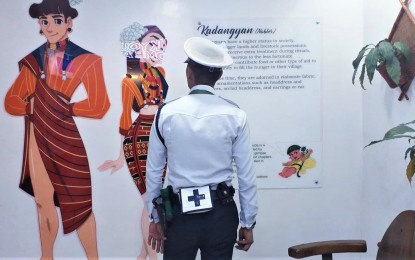
KADANGYAN. The nobles or the rich people of the Cordilleras as seen in this acrylic figure illustrated by Tor Sagud of Gripo Comics adorn the walls of the Puso ng Baguio building along Session Road. In this photo, a security guard looks at the eight-foot artwork. (PNA photo by Pigeon M. Lobien)
BAGUIO CITY -- Who else can portray what an Igorot is but an Igorot? With Igorotak, illustrator–artist Tor Sagud came out with an easy to read comic book that best describes what an Igorot is and the seven tribes found mostly in the Cordilleras and nearby Cagayan province.
Sagud published the book last September and has fared well in terms of sales and reception.
Now, his works are on display at one of the malls here.
The book, published by Gripo Comics and Watwat Productions, is an illustrated guide authored and illustrated by Sagud that “gives a basic glimpse of Cordillera heritage in short chapters and the subjects are illustrated in comic-style manner.”
Eight sets of figures in acrylic plastic measuring eight foot each now adorn the stairways of the Puso ng Baguio building or the Porta Vaga Mall along Session Road.
Sagud’s artistic drawings of the seven tribes of the Cordillera (mountain range) “come to life” that serve to welcome patrons of the mall right at the heart of the city.
From the left entrance, right before hitting the stairs are figures of two Igorots in elaborate loincloth or “bahag” and skirt and adorned with beaded ornaments such as headdress and necklaces and earrings.
These are the Kadangyans, or roughly translated to nobles.
Each set of illustration has a description. For Kadangyans, Sagud wrote: “Kadangyans have a higher status in society. They have bigger lands and livestock possessions. Though they receive extra treatment during rituals, they are still generous to the less fortunate.”
The figures include that of the Kankana-ey, Ibaloy, Kalinga, Ifugao, Isnag of Apayao and Tingguian of Abra -- all of the Cordilleras -- and the Gaddang of Cagayan Valley.
Kankana-eys are described as those who inhabit western Mountain Province, Benguet, and southern Ilocos.
Sagud said there are two distinct features of the tribe’s language, the “hard” or the Applais that include Sagada and Besao, while the “soft” is spoken by those from northern Benguet, Sabangan, Tadian, and Bauko in Mountain Province.
Sagud, a Kankana-ey, said they are distinguished by their attires. The G-string, for instance of I-Sagada and I-Besao is called “wanes”, while the skirt or “tapis” for females has a waistband called “wakes”.
The “soft” speaking Kankana-eys “is a combination of black, white and red while among the 'hard', the band is red and black.”
Sagud added the Kankana-eys have major dances, namely “tayaw” for community celebration and wedding, “pattong” meant to drive away bad spirits, “balangbang" or the common dance and “takik” for weddings.
Those who inhabit the southern part of Benguet, including Baguio City, are the Ibaloys or sometimes called as Kafagway or “those who live in the grasslands.”
Sagud further wrote that Ibaloys are “traditionally an agrarian society and still practice mountain rice farming and livestock-raising.”
Perceived as reticent, the Ibaloys are often called “shy mango”. They do the “bendiyan” dance which is participated in by hundreds of men and women in the community. These people celebrate a grand feast called ‘pesshet’ which could last for weeks.
There is also the fierce-looking Bontocs, who live at the banks of the Chico River in central Mountain Province, who “used to practice head-taking and are known for their impressive body tattoos.”
The Kalingas, who live in the middle area of the Chico River, were also head hunters but Sagud said the concept that outlasted this is their strong sense of community and the ‘bodong’ or the peace pact which minimized inter-tribal conflicts.
He added that the Kalingas are also once called the “peacocks” of the Cordillera with their “ornate fashion”.
Gripo Comics is a group of illustrators whose members are of Cordillera blood. It was founded by Majic Asbucan, of the Lubuagan stock of Kalinga and serves as president, while Sagud is the group's vice president.
Members include young budding artists, who were former students of Sagud, while he was teaching arts and design at the Baguio College of Technology.
The group recently launched another offering, a comic book on Cordillera myth. (PNA)
